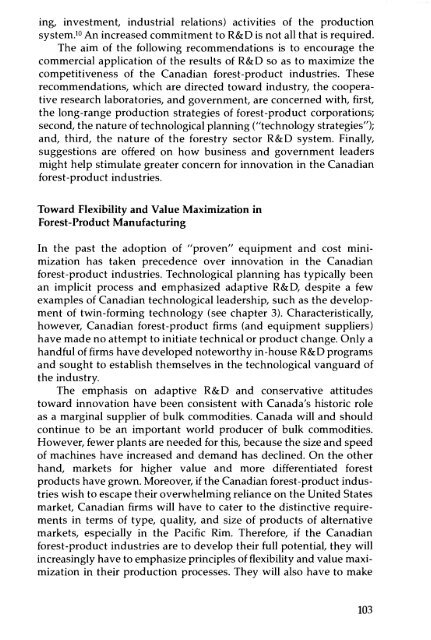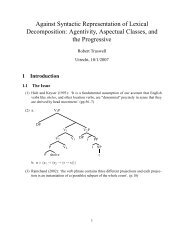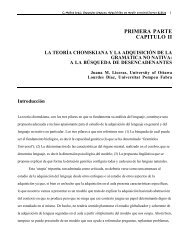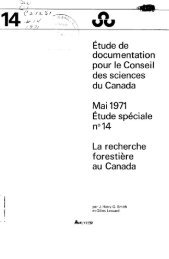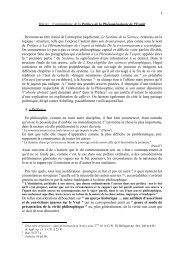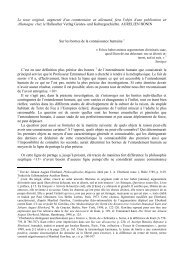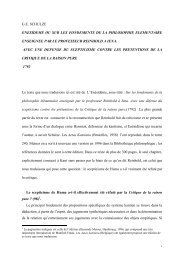Technology and the Canadian Forest-Product Industries ... - ArtSites
Technology and the Canadian Forest-Product Industries ... - ArtSites
Technology and the Canadian Forest-Product Industries ... - ArtSites
Create successful ePaper yourself
Turn your PDF publications into a flip-book with our unique Google optimized e-Paper software.
ing, investment, industrial relations) activities of <strong>the</strong> productionsystem.'? An increased commitment to R&D is not all that is required.The aim of <strong>the</strong> following recommendations is to encourage <strong>the</strong>commercial application of <strong>the</strong> results of R&D so as to maximize <strong>the</strong>competitiveness of <strong>the</strong> <strong>Canadian</strong> forest-product industries. Theserecommendations, which are directed toward industry, <strong>the</strong> cooperativeresearch laboratories, <strong>and</strong> government, are concerned with, first,<strong>the</strong> long-range production strategies of forest-product corporations;second, <strong>the</strong> nature of technological planning ("technology strategies");<strong>and</strong>, third, <strong>the</strong> nature of <strong>the</strong> forestry sector R& D system. Finally,suggestions are offered on how business <strong>and</strong> government leadersmight help stimulate greater concern for innovation in <strong>the</strong> <strong>Canadian</strong>forest-product industries.Toward Flexibility <strong>and</strong> Value Maximization in<strong>Forest</strong>-<strong>Product</strong> ManufacturingIn <strong>the</strong> past <strong>the</strong> adoption of "proven" equipment <strong>and</strong> cost rrurumizationhas taken precedence over innovation in <strong>the</strong> <strong>Canadian</strong>forest-product industries. Technological planning has typically beenan implicit process <strong>and</strong> emphasized adaptive R&D, despite a fewexamples of <strong>Canadian</strong> technological leadership, such as <strong>the</strong> developmentof twin-forming technology (see chapter 3). Characteristically,however, <strong>Canadian</strong> forest-product firms (<strong>and</strong> equipment suppliers)have made no attempt to initiate technical or product change. Only ah<strong>and</strong>ful of firms have developed noteworthy in-house R&D programs<strong>and</strong> sought to establish <strong>the</strong>mselves in <strong>the</strong> technological vanguard of<strong>the</strong> industry.The emphasis on adaptive R&D <strong>and</strong> conservative attitudestoward innovation have been consistent with Canada's historic roleas a marginal supplier of bulk commodities. Canada will <strong>and</strong> shouldcontinue to be an important world producer of bulk commodities.However, fewer plants are needed for this, because <strong>the</strong> size <strong>and</strong> speedof machines have increased <strong>and</strong> dem<strong>and</strong> has declined. On <strong>the</strong> o<strong>the</strong>rh<strong>and</strong>, markets for higher value <strong>and</strong> more differentiated forestproducts have grown. Moreover, if <strong>the</strong> <strong>Canadian</strong> forest-product industrieswish to escape <strong>the</strong>ir overwhelming reliance on <strong>the</strong> United Statesmarket, <strong>Canadian</strong> firms will have to cater to <strong>the</strong> distinctive requirementsin terms of type, quality, <strong>and</strong> size of products of alternativemarkets, especially in <strong>the</strong> Pacific Rim. Therefore, if <strong>the</strong> <strong>Canadian</strong>forest-product industries are to develop <strong>the</strong>ir full potential, <strong>the</strong>y willincreasingly have to emphasize principles of flexibility <strong>and</strong> value maximizationin <strong>the</strong>ir production processes. They will also have to make103


